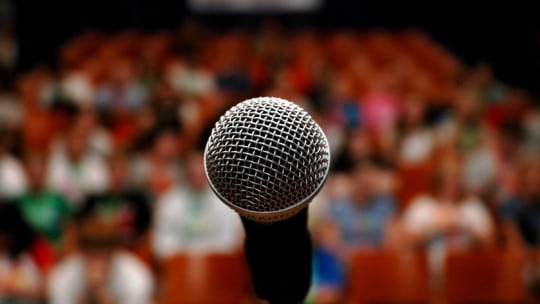

To be an effective and persuasive presenter, you must build trust and believability in the audience’s mind. The goal of presenting is likely to inform the audience of something or persuade it to act or not. To do this successfully, the speaker must be believable and likeable.
Credibility is not a naturally occurring phenomenon. People are not born credible presenters. Credibility is something a speaker must gradually build in the mind of the audience.
There are strategies for crafting credibility that can be implemented to ensure success as a presenter. The following should be done before, during and after your presentation.
Before You Present
1. As PR professionals we know the importance of having a strong digital identity. This includes a professional LinkedIn page and appropriate social media accounts. People sometimes forget that first impressions can be formed long before actually meeting another individual. Cleaning up your digital image is the first step in ensuring a successful presentation.
2. As a speaker, you should analyze your audience to determine an appropriate topic. Factor in the audience’s knowledge level, as well as its interests, to decide on a topic. This allows you to customize your presentation for maximum impact on the audience. Research who will be in your audience, its size, demographics and even the goals it has for listening to you speak.
3. Everyone knows that preparation is a key to success. There is no magic formula for how many times you should practice the presentation before you deliver it, however. Unless you need to present from memory, it’s suggested you practice the material until you are comfortable, without adding the extra pressure of memorizing it. You do not want the pressure of having a memorized presentation where you freeze midway through and cannot remember the next steps. This also allows flexibility to adapt the presentation, in case you see your audience fading or losing interest.
4. The last step in boosting your credibility prior to your talk is to dress well. A strong professional outfit will reflect your qualifications to speak. It also will boost your confidence. There is something to be said for putting on a flattering, new outfit to make a presentation.
Now that you have done as many things as possible to ensure success, here are tips on how to improve your credibility while you are presenting.
During The Presentation
5. Eye contact is very important and one of the strongest nonverbal messages you can send. Those who read directly off the PowerPoint or rely heavily on note cards signal unpreparedness and/or a lack of confidence.
If you bond with your audience through good eye contact, then the audience will tend to trust you more. Including interactive or engaging activities, questions or references to the audience will make it feel more involved in the presentation. Strong visual aids are recommended for most presentations.
6. Unfortunately, most of us have fallen victim to death by PowerPoint. This is what audiences experience from being forced to sit through a bad slideshow, with too much text or a lack of images. Be mindful that PowerPoint is a supplemental visual aid to your presentation, not the presentation itself. Although it’s tempting, do not use it as a crutch and keep your body, eye contact and focus on the audience rather than the screen.
As You End
7. Some people have a tendency to conclude presentations by saying, “That’s it,” “I’m done,” or “That’s all I’ve got.” Why not end with a strong moment where you leave a memorable mark on the audience? Leave it wanting more?
Avoid closing with a question-and-answer period. Although this is the traditional format, it leaves the door open for someone to ask a question that stumps you. Is this the last thing you want the audience to hear? It might tear down the goodwill you have built up during the presentation.
Rather, ask if there are questions prior to your conclusion. That way, if someone asks a question you do not know the answer to, you still can regain control of the audience and conclude with your strong moment.
Although this is an unusual structure to a presentation that sometimes tricks the audience into thinking your presentation is over, it can be effective if you say, “Before I conclude my presentation today, do you have questions?” This way the audience knows the presentation will continue, but it has a chance to ask questions.
After You Present
8. If there is an opportunity to follow up with the organization that arranged for you to present, you should, immediately. A handwritten thank-you note will go a long way toward showing you are a professional. It works great after a job interview, too.
Public speaking can be stressful; however, if you keep your focus on building rapport with the audience by boosting your credibility, you can be a successful speaker and presenter.
Editor’s Note:For additional insight about public speaking join our public speaking webinar, June 23, 2016, 1:30pm ET. Info at: https://www.prnewsonline.com//pr-news-webinars
CONTACT: [email protected]
